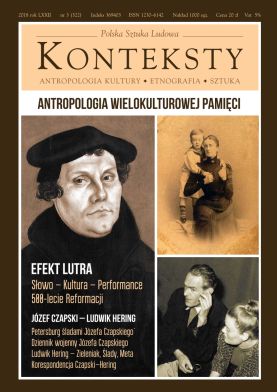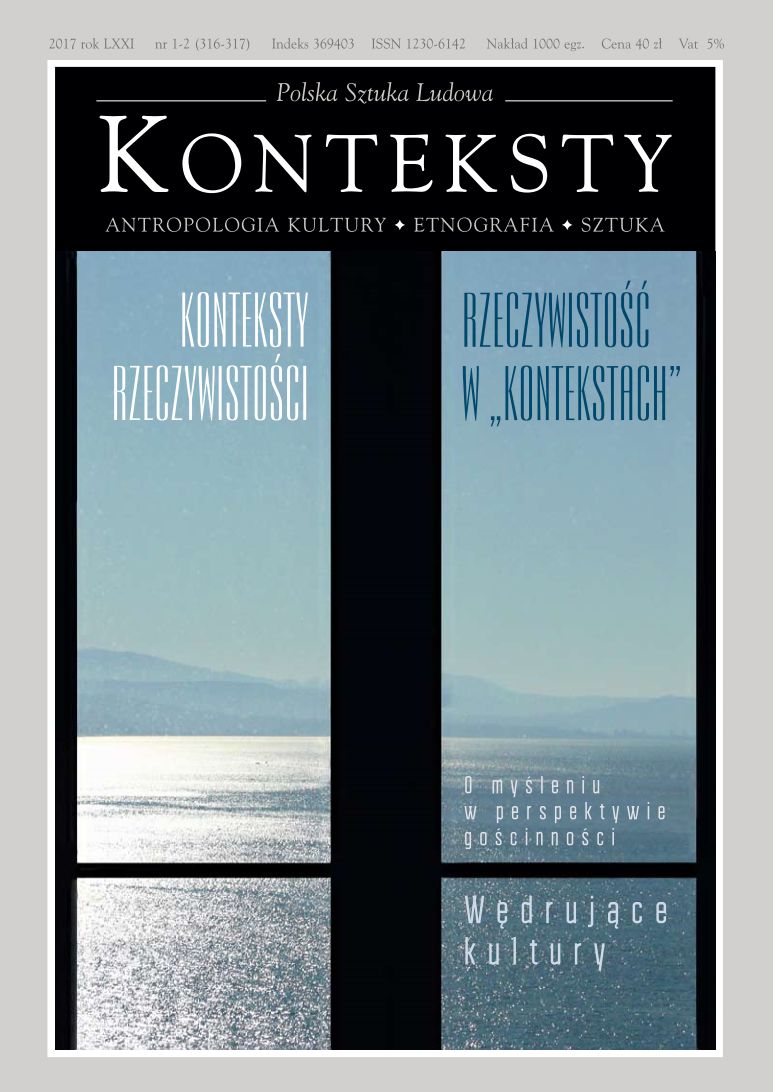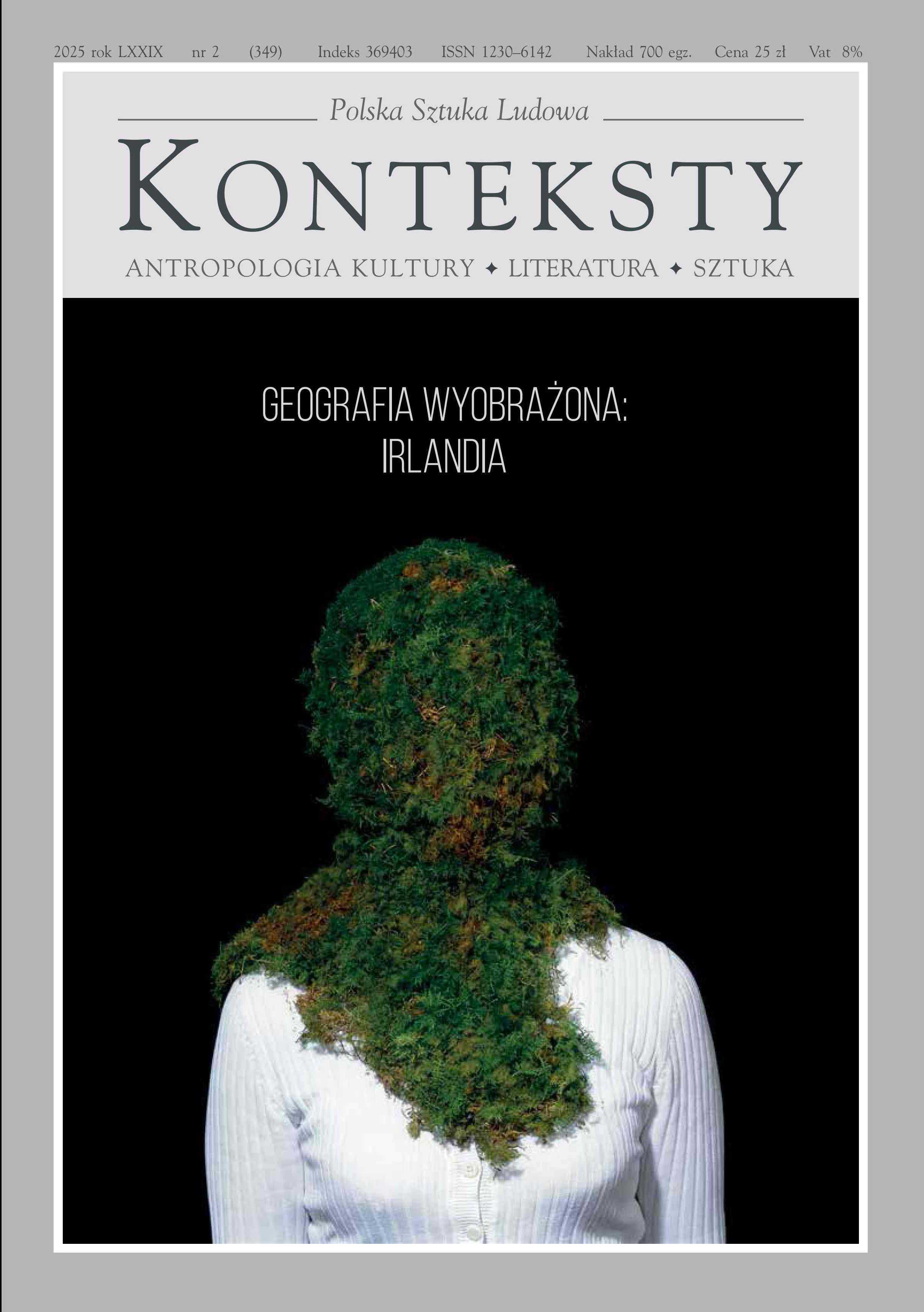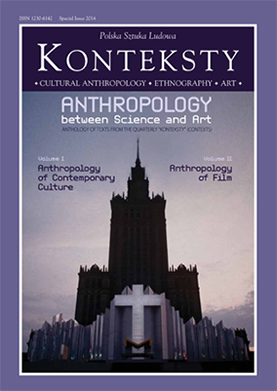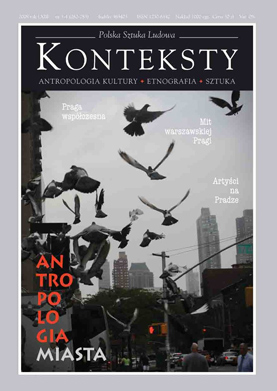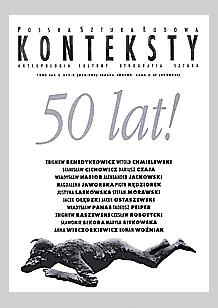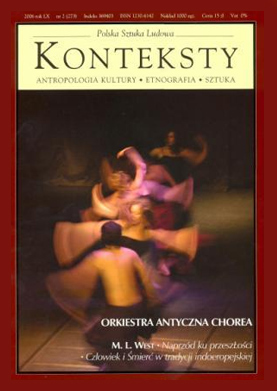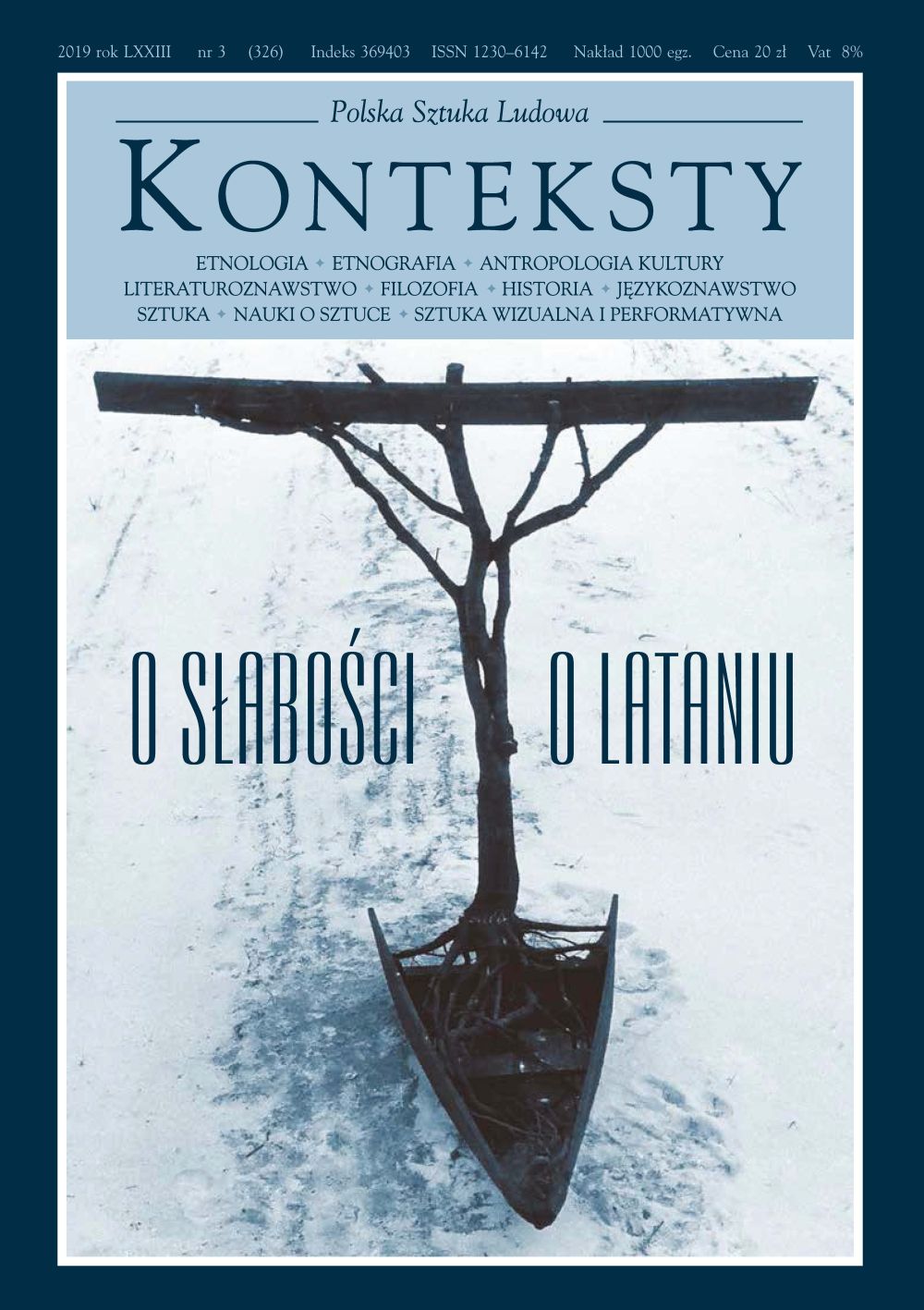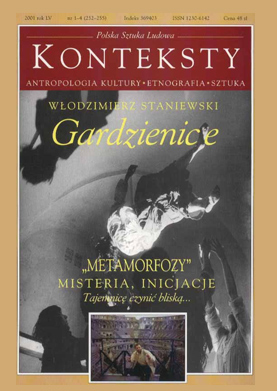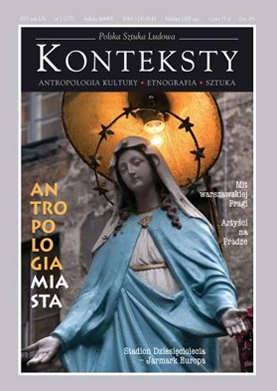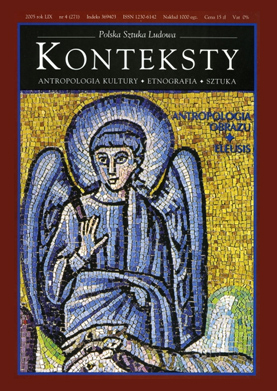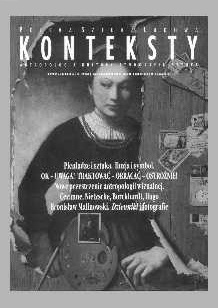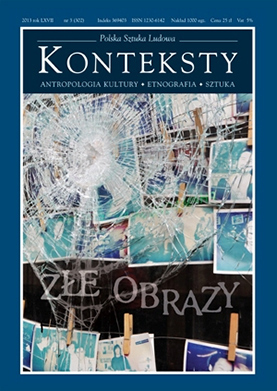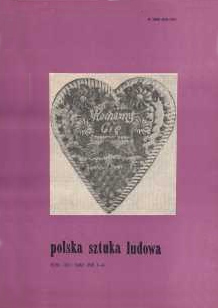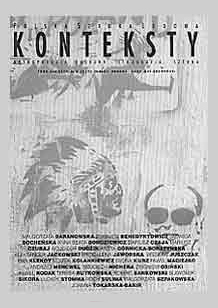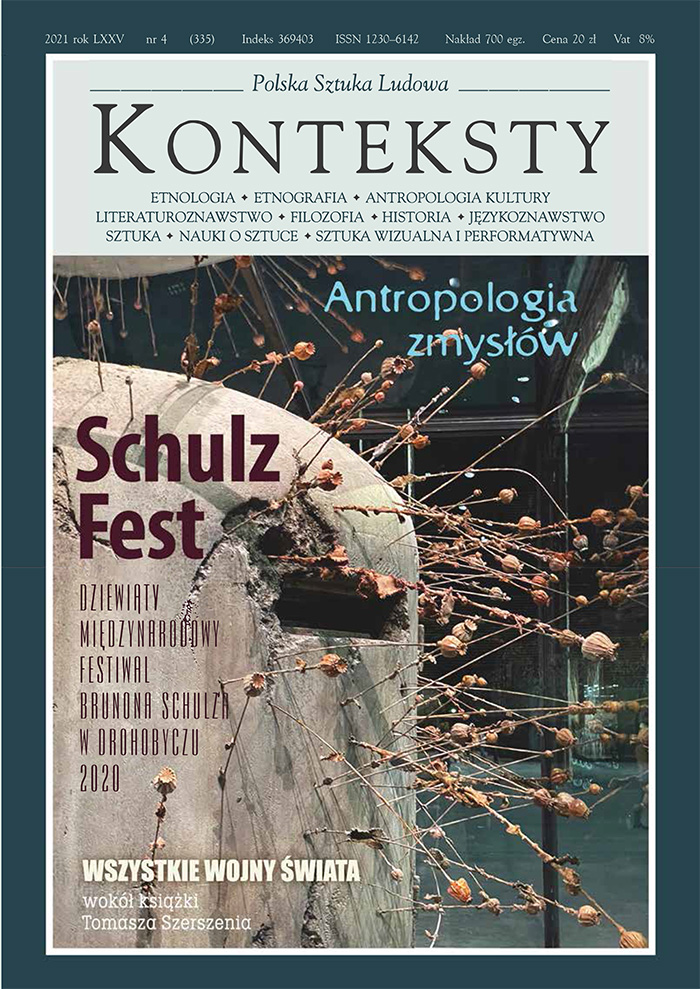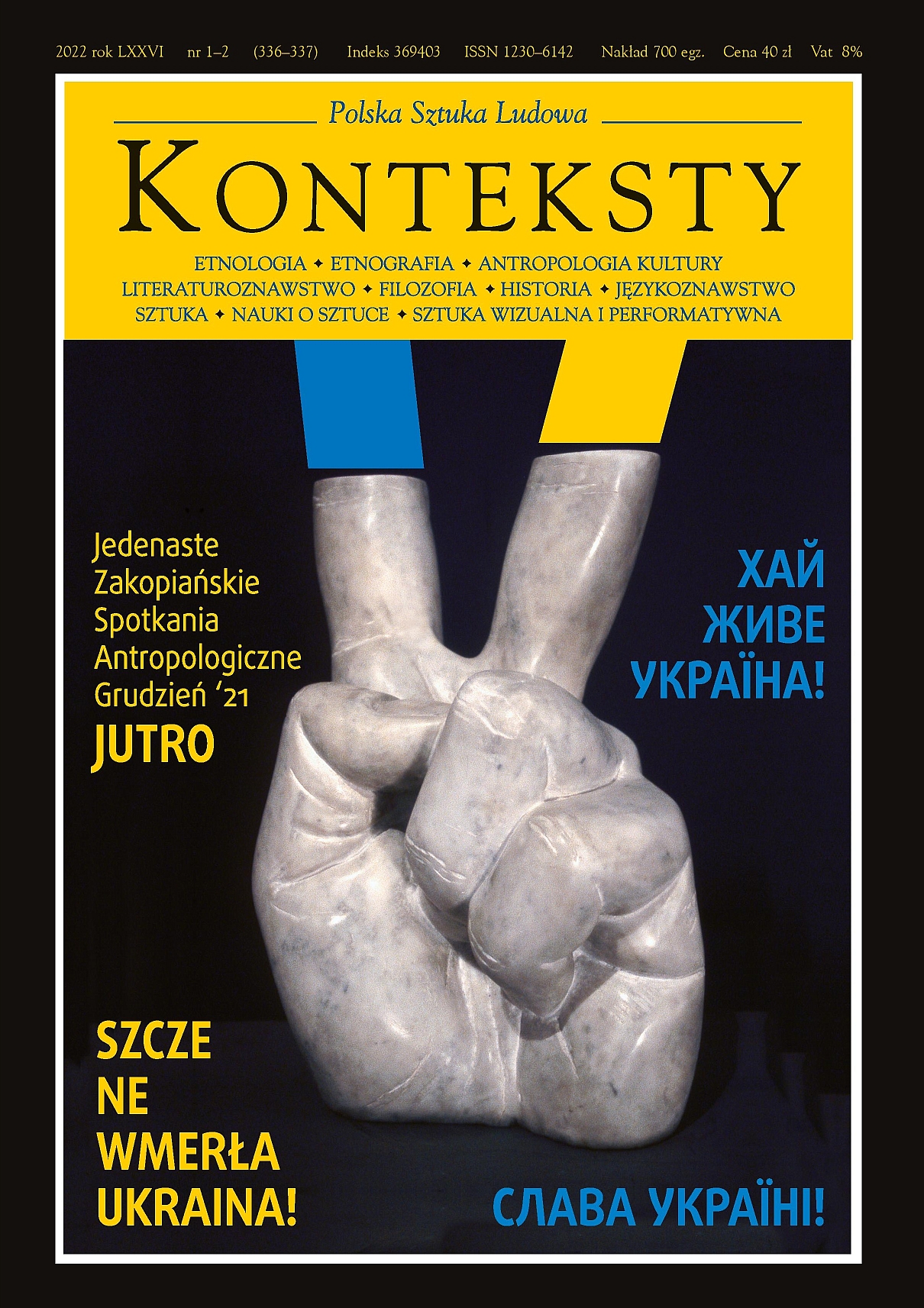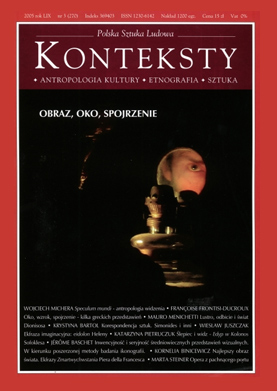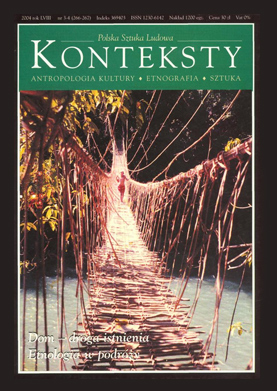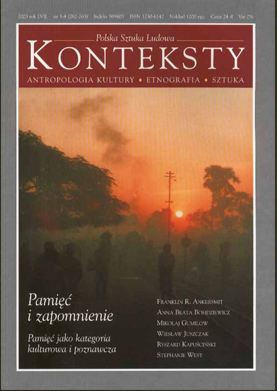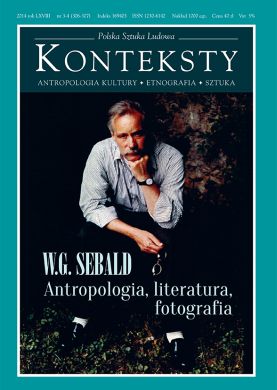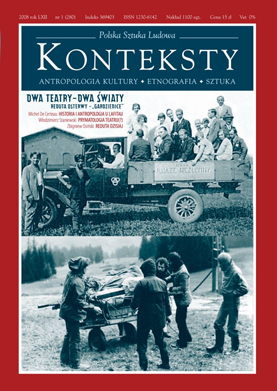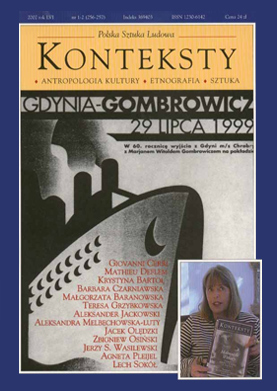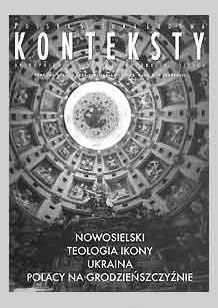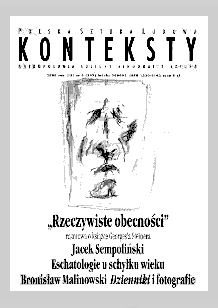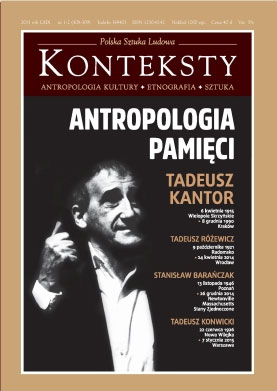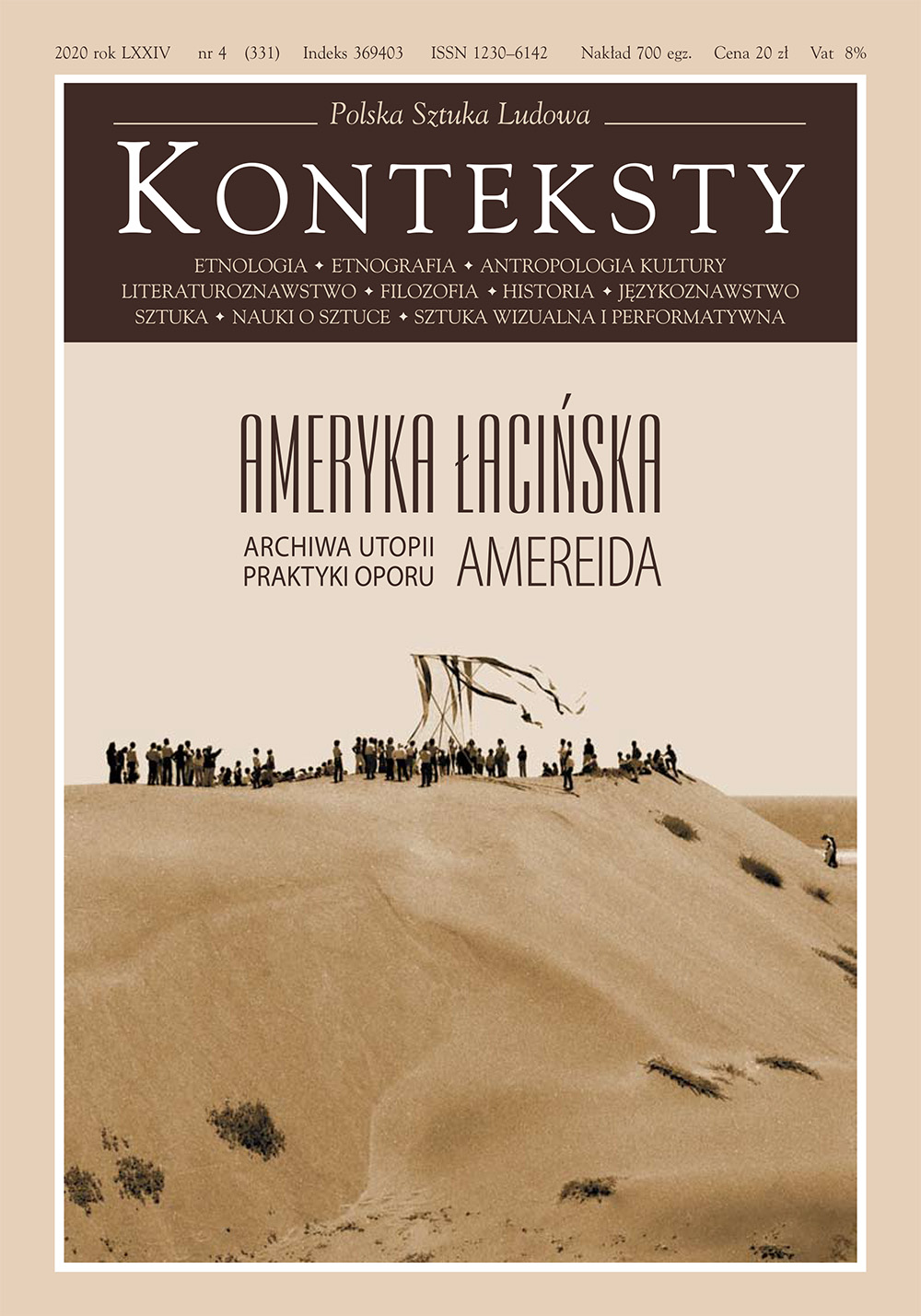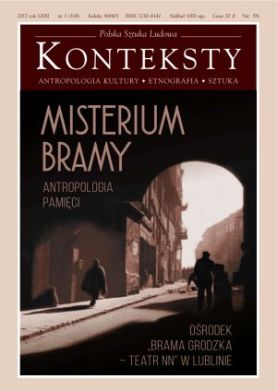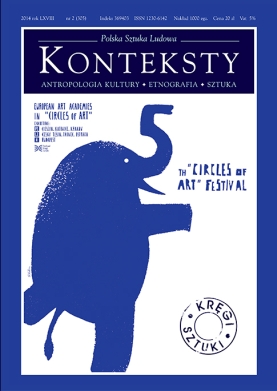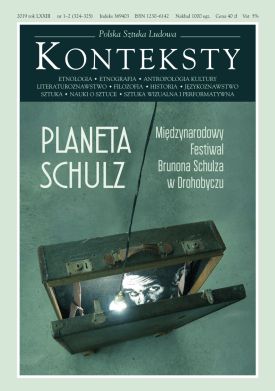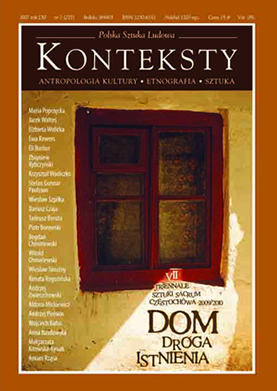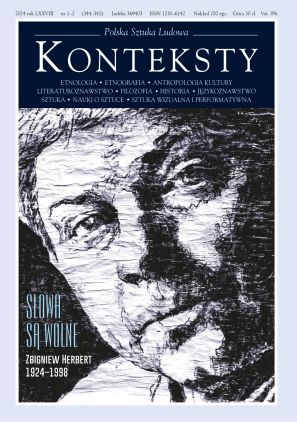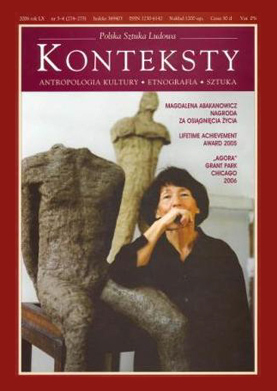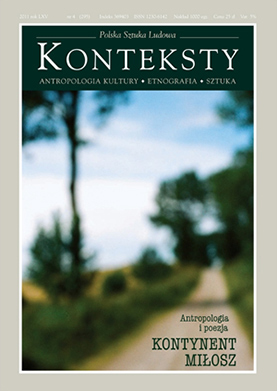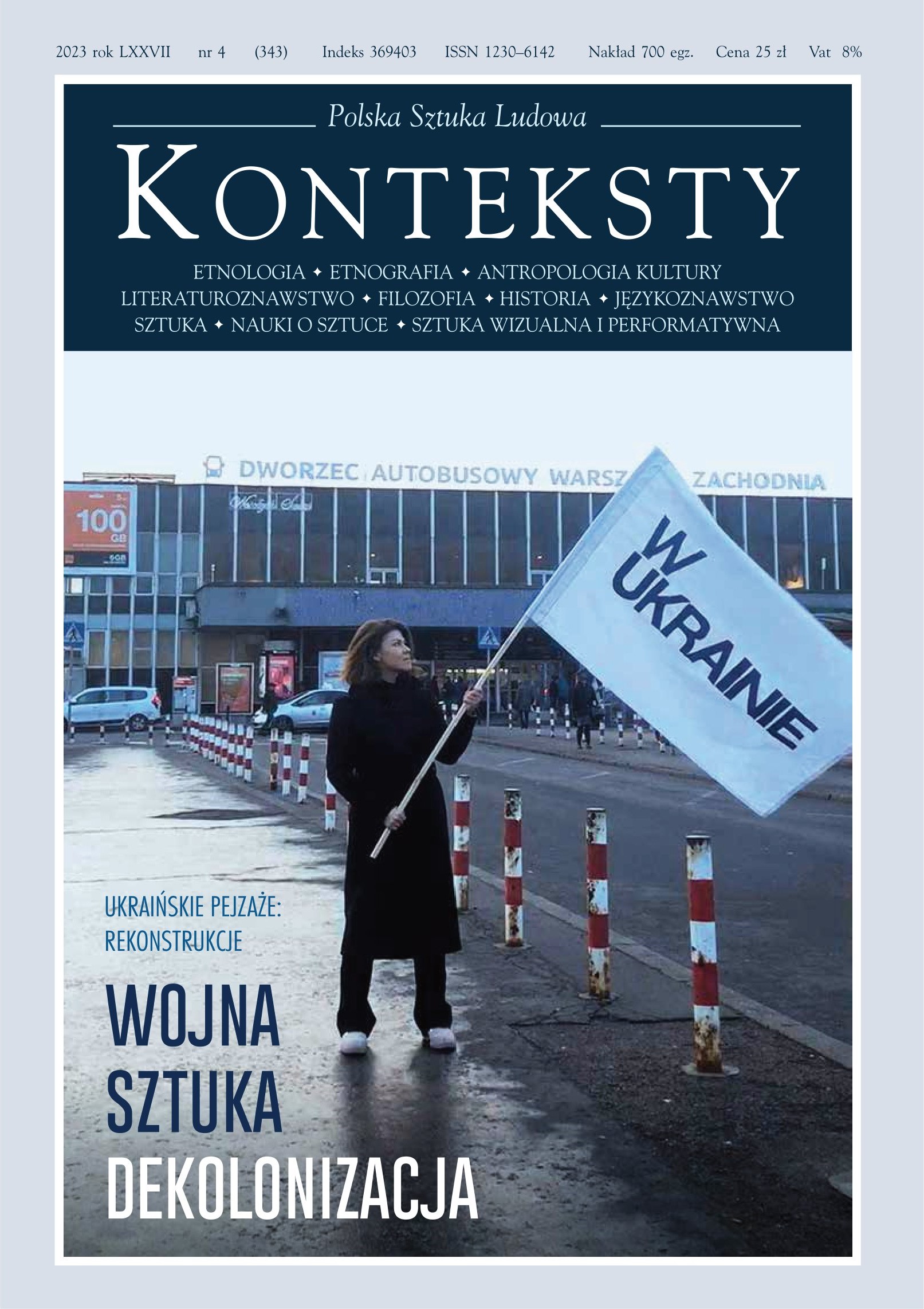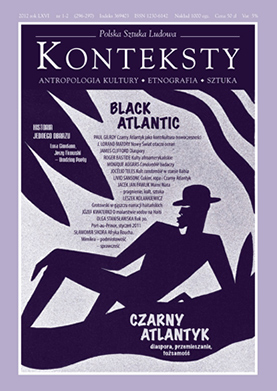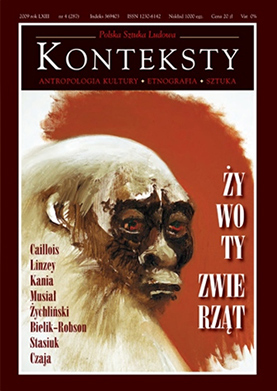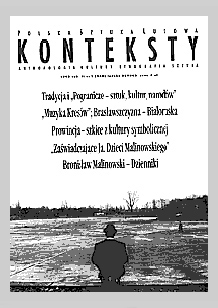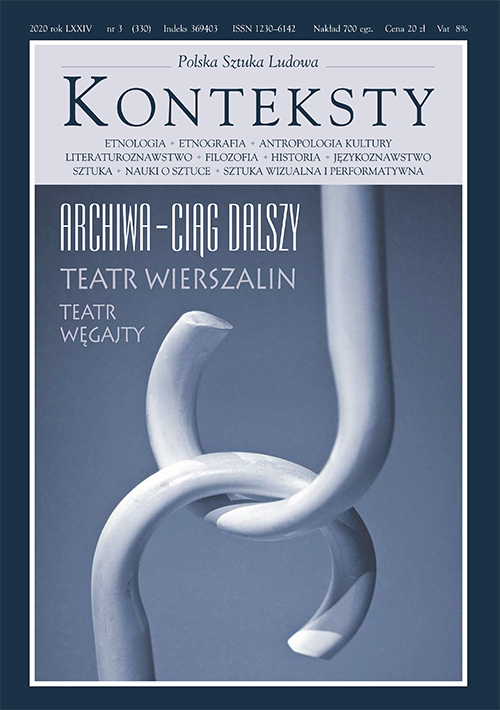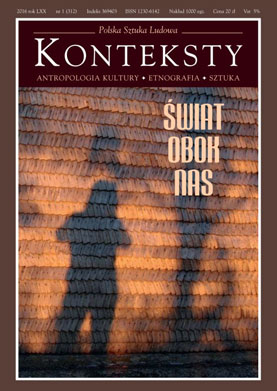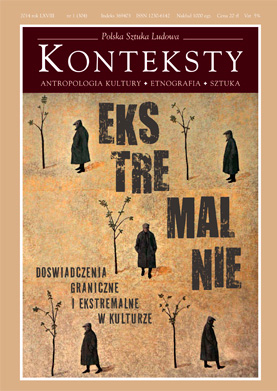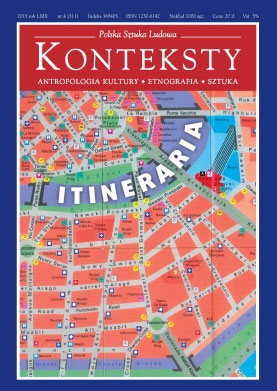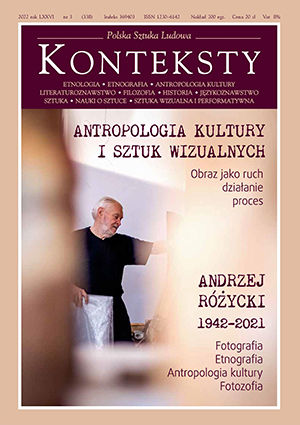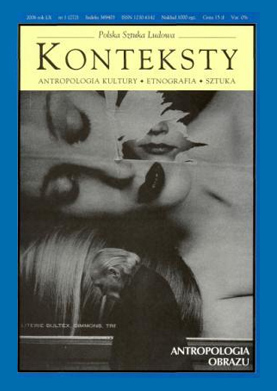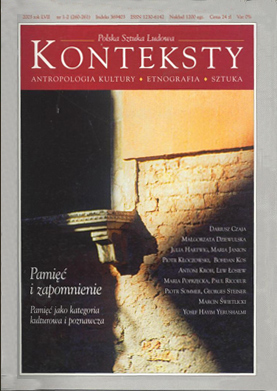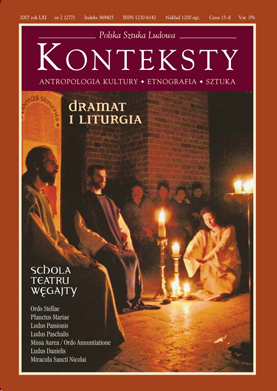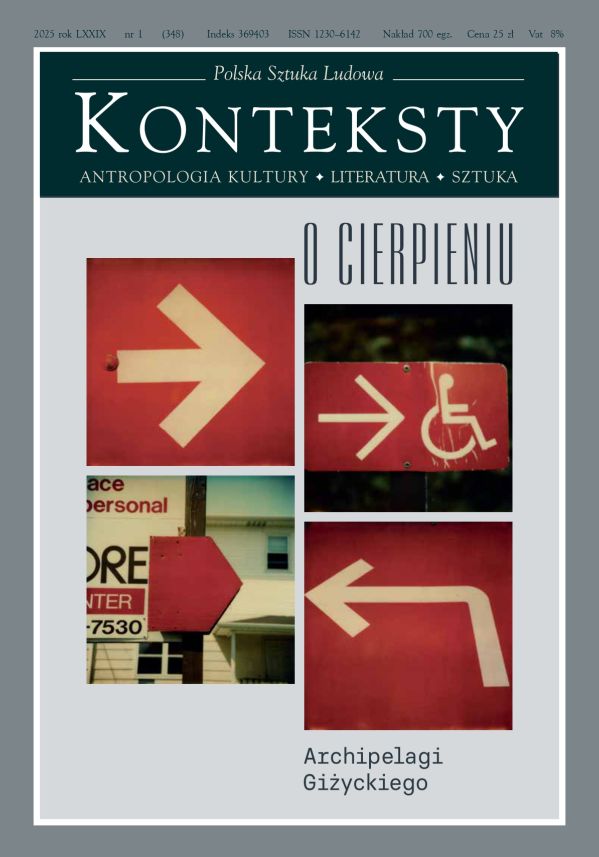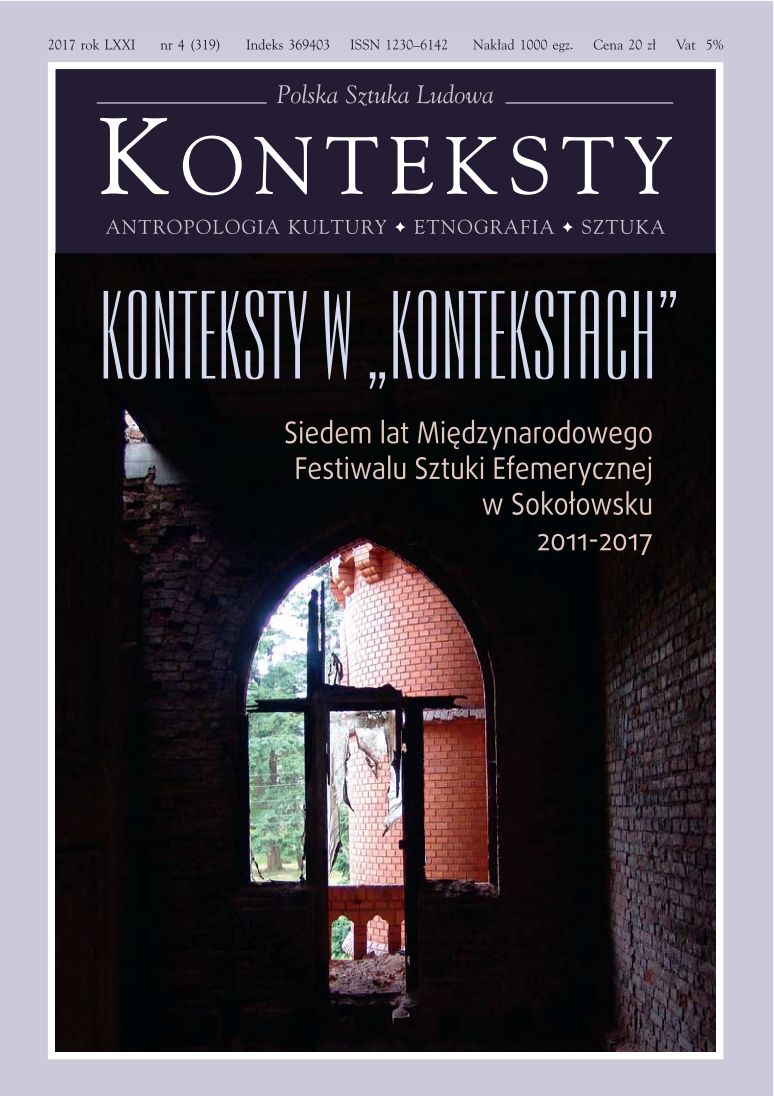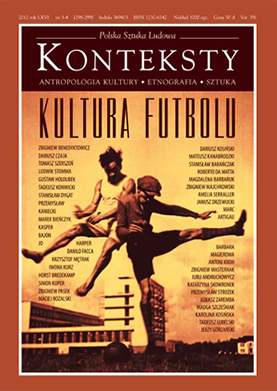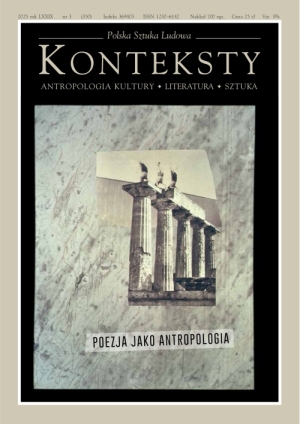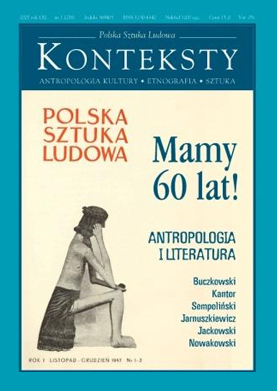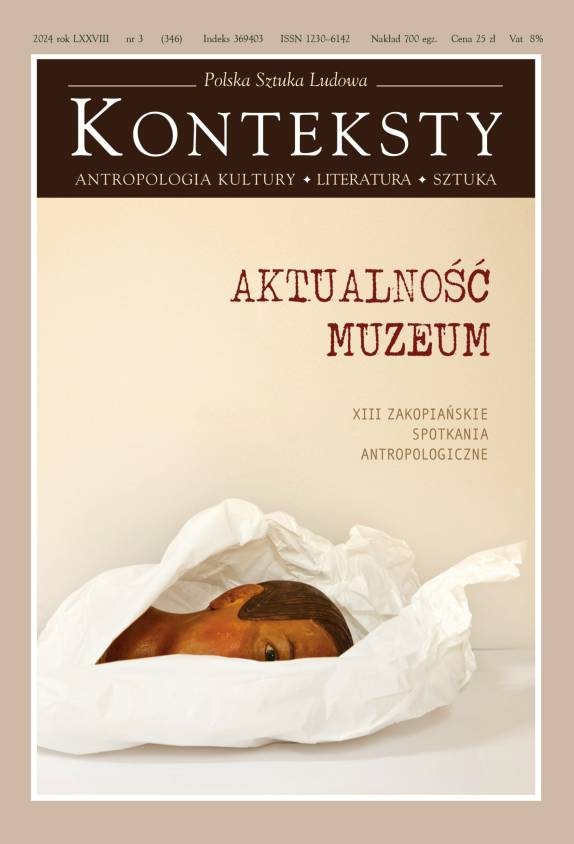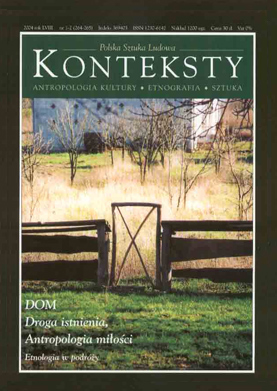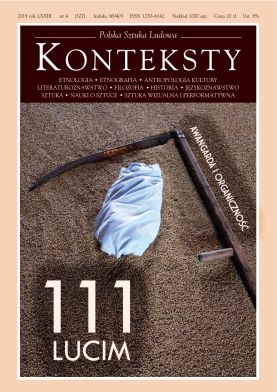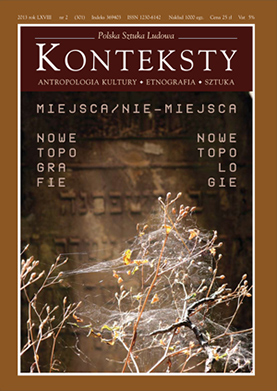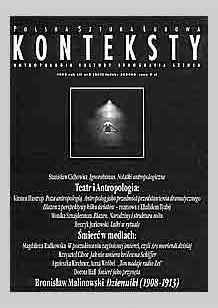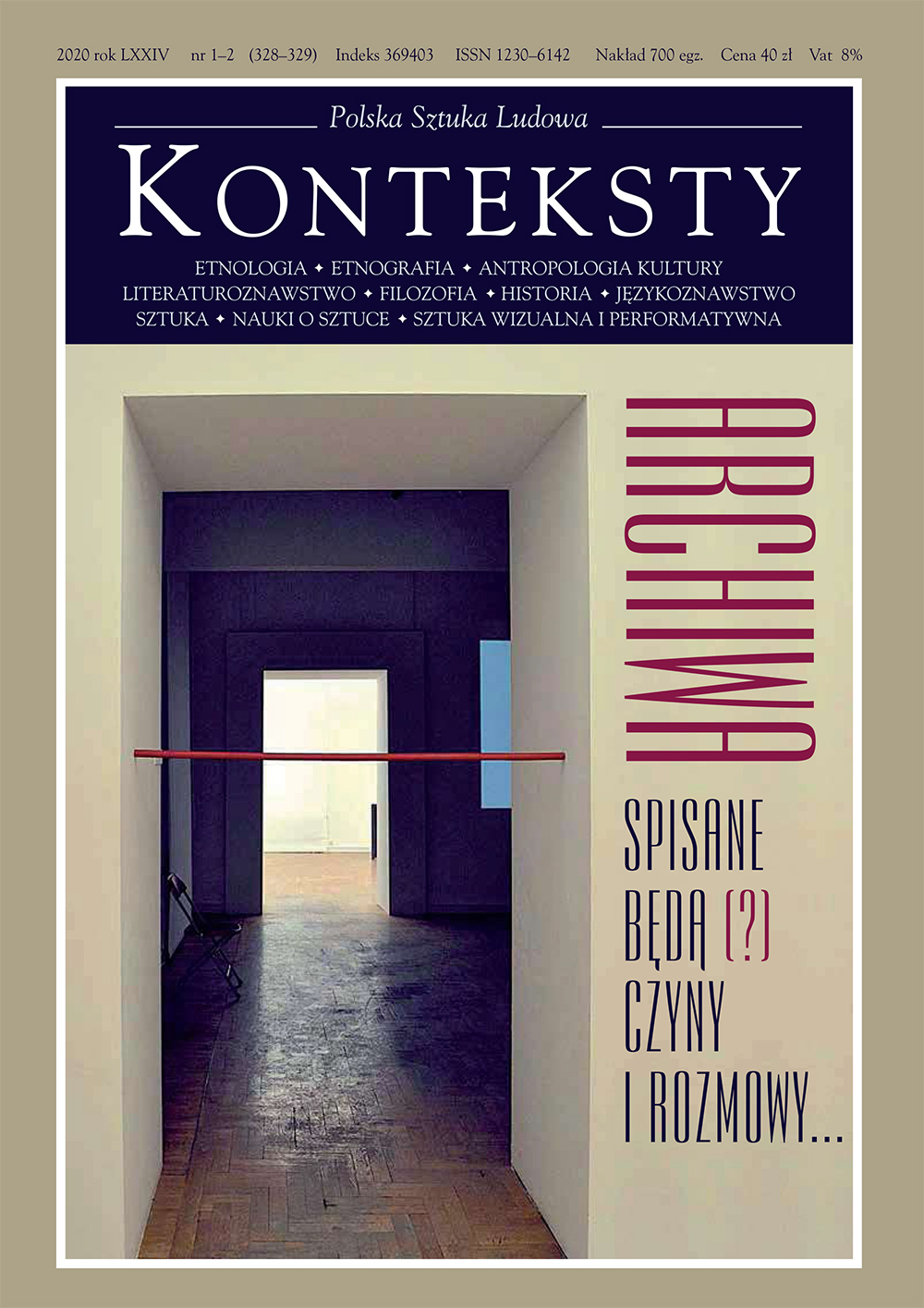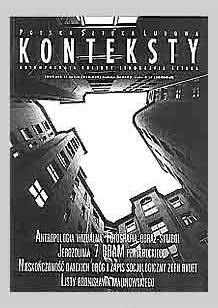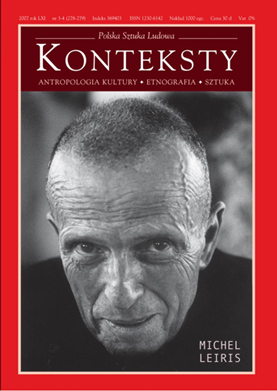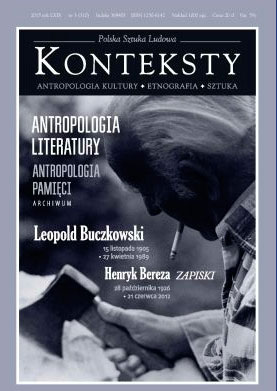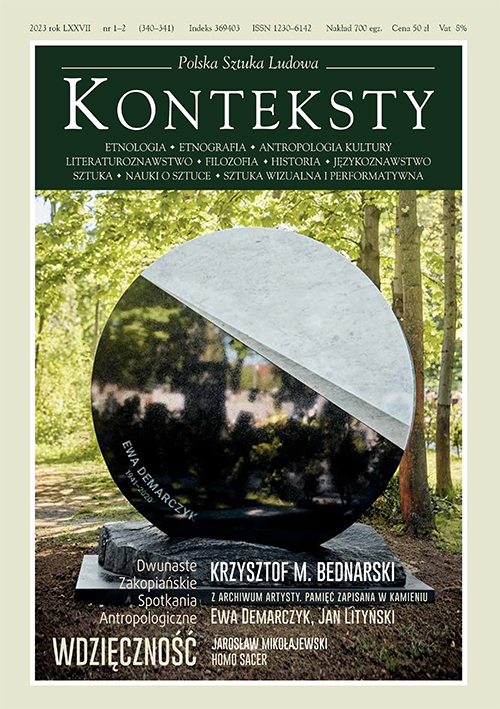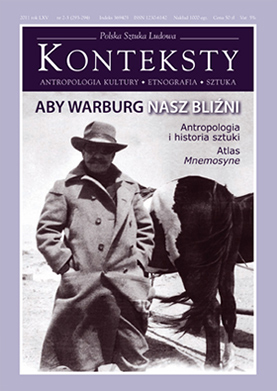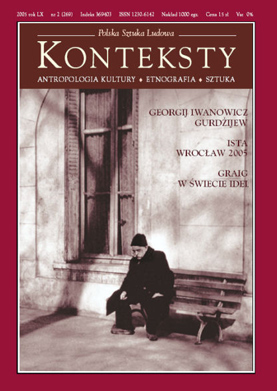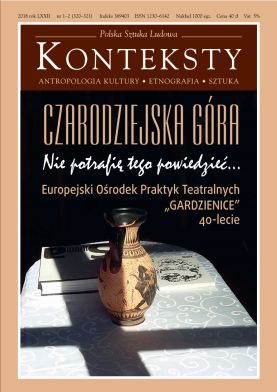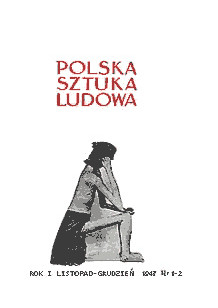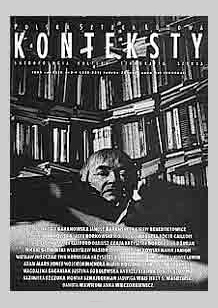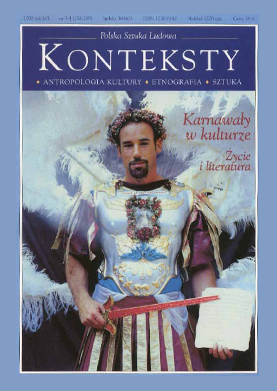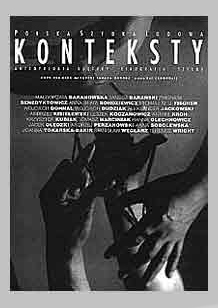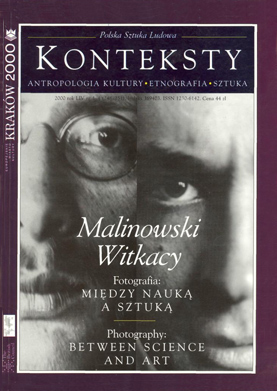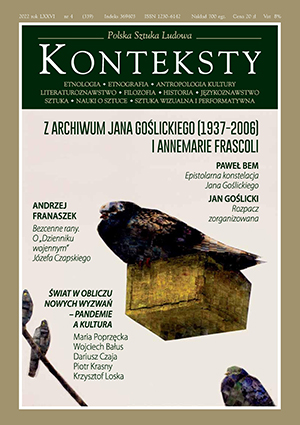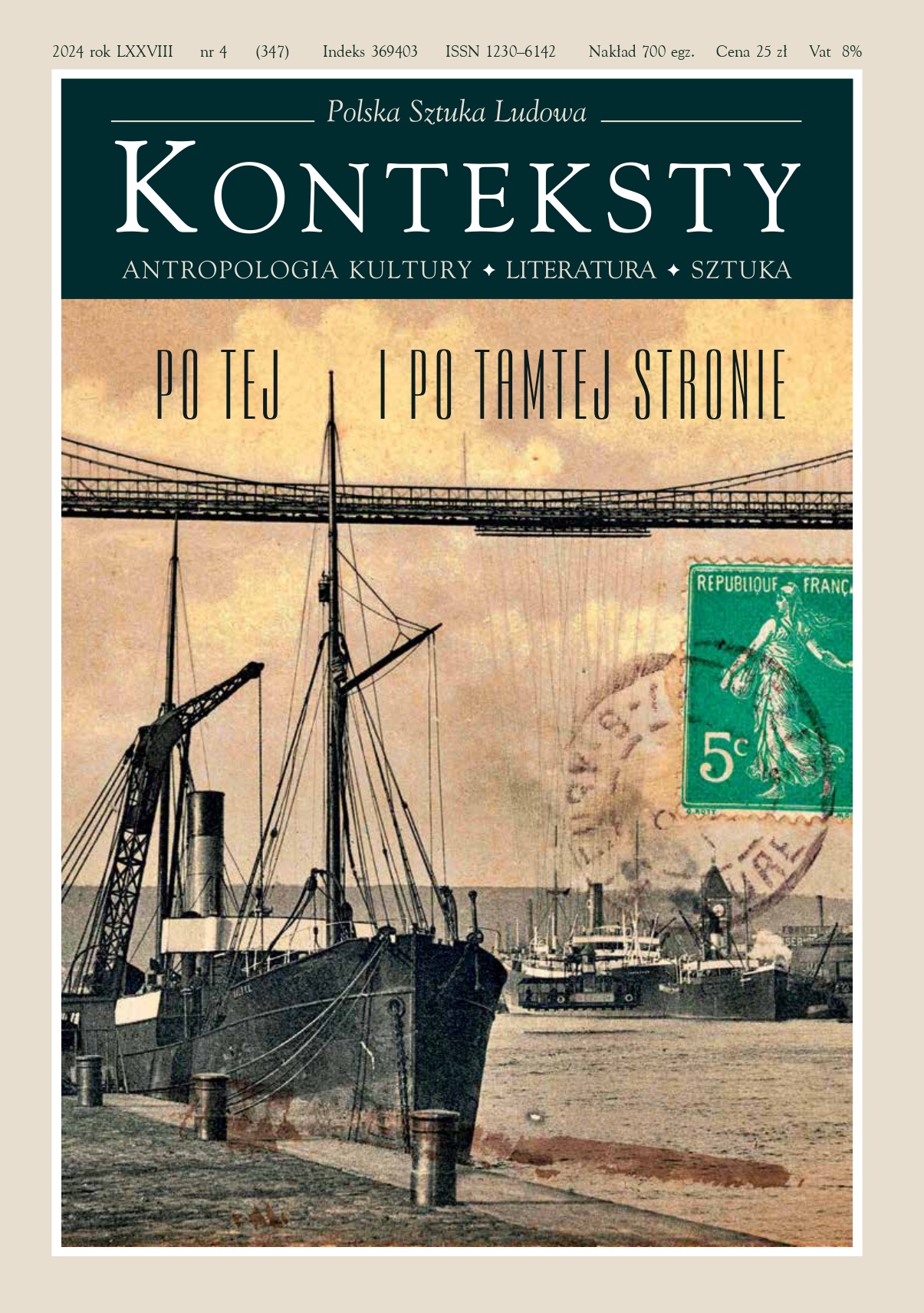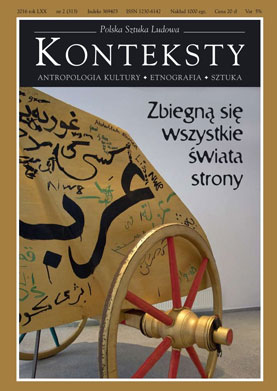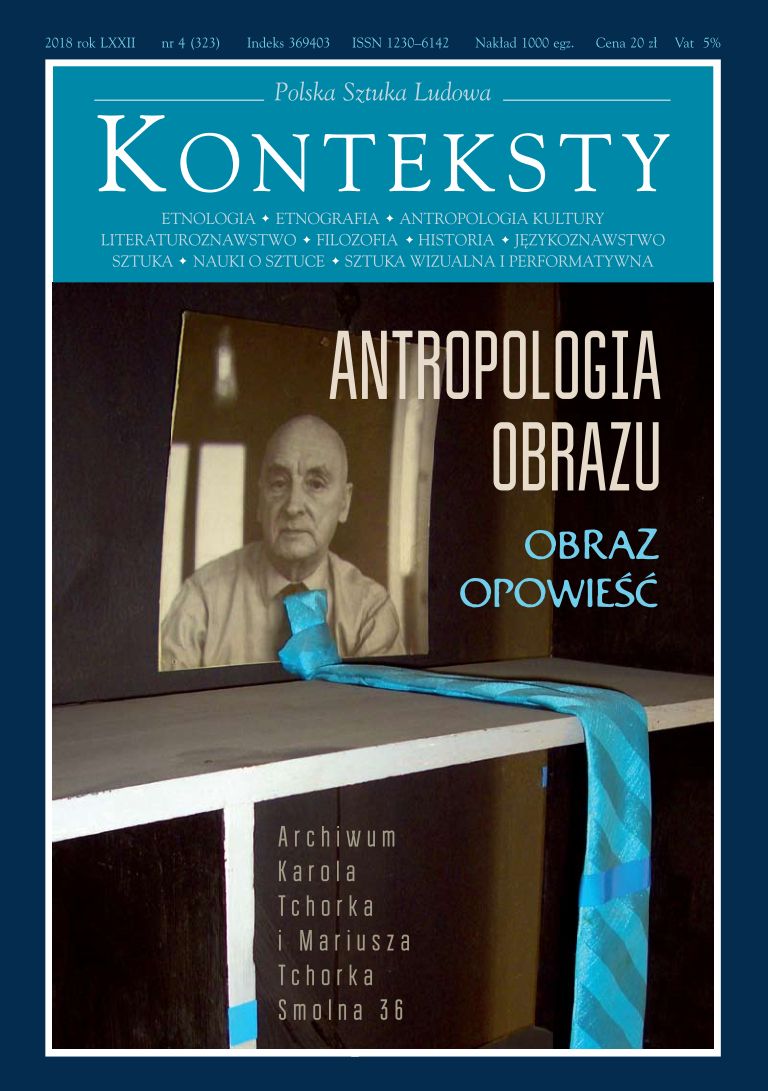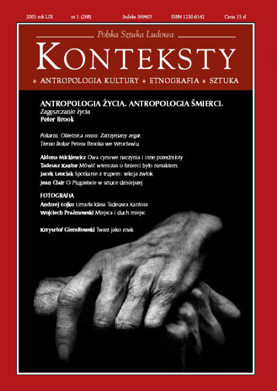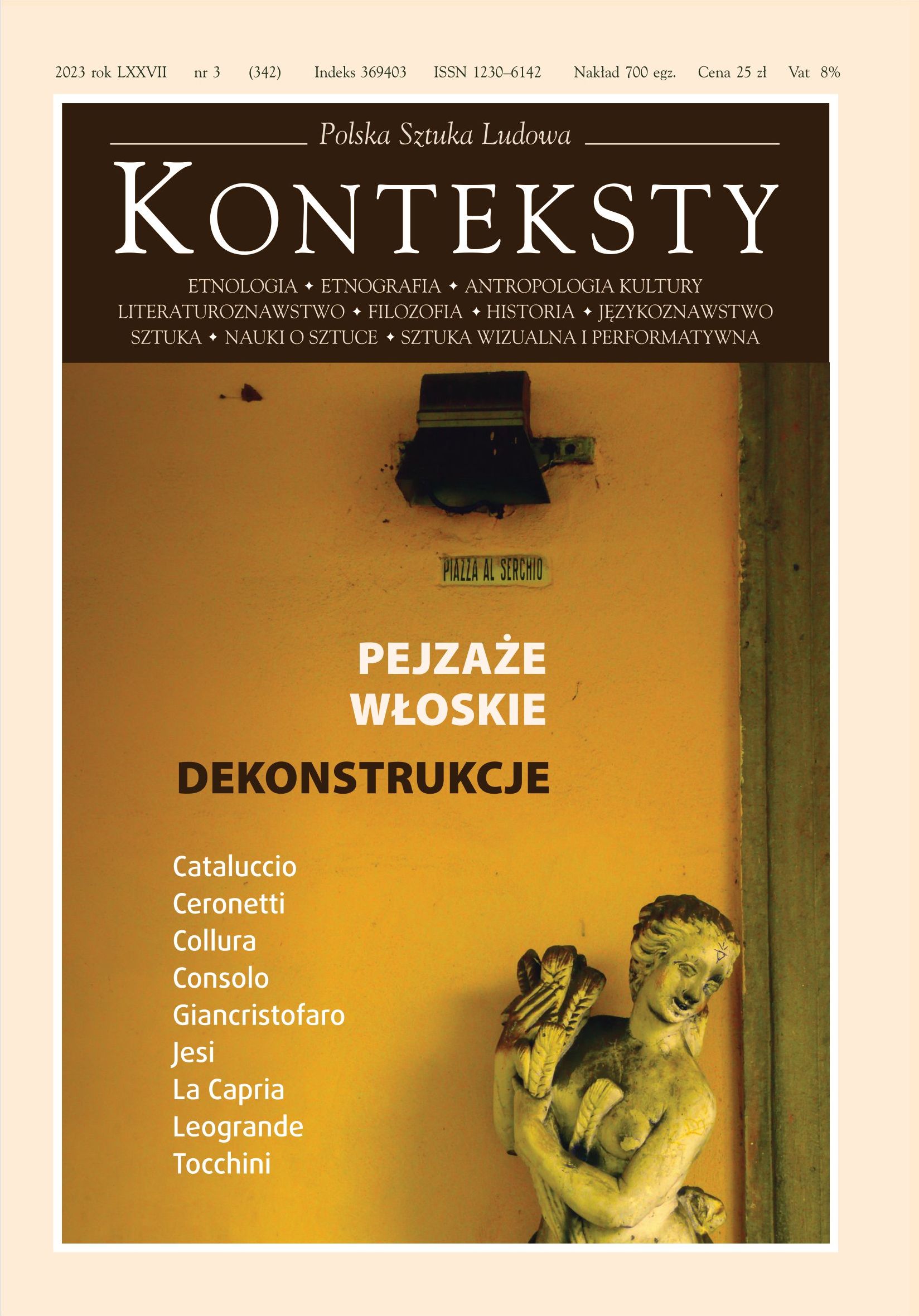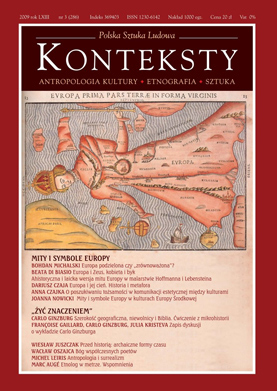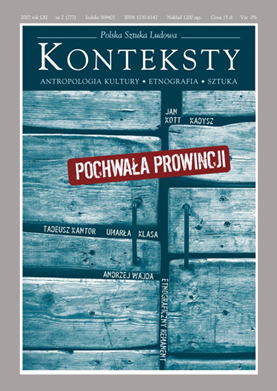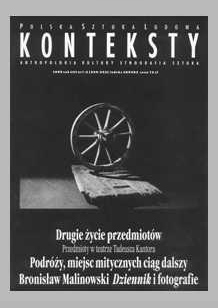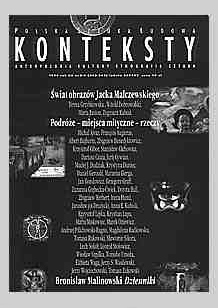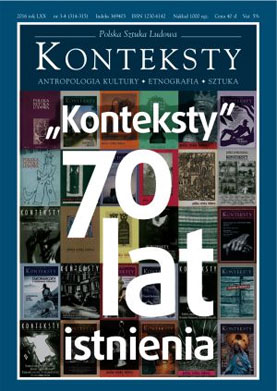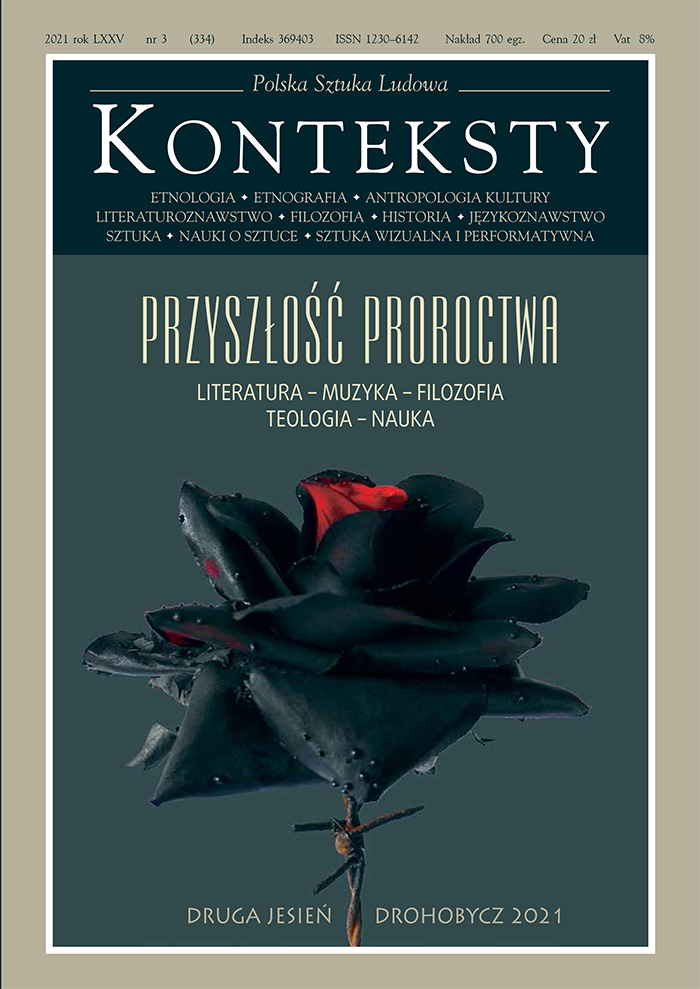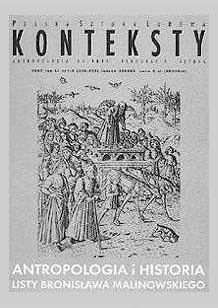Issue 2021/1-2 (332-333) - Ludwik Stomma - Frames of Memory - Column of Words
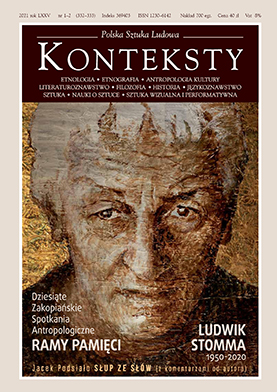
| *** | ||
| Zbigniew Benedyktowicz | I Am Unprepared | 6 |
| Kuba Szpilka | Dedication for Ludwik Stomma | 9 |
| Stanisław Krajewski | Contexts and Labours of Testimony  | 11 |
The article presents the structure of testimony and certain aspects of its frames, such as truthfulness. The proposed examples are situations associated with mountains, mathematics, and religion, demonstrating the omni-presence and significance of the phenomenon that is testimony. | ||
| Monika Krajewska | Frames of Worlds. Visual Commentary on ‘Dybuk’, the Drama by An-ski. Between Two Worlds  | 15 |
The author proposes a selection of her works from the Dybuk (Dybbuk) cycle, a combination of the paper cut-out technique derived from traditional Jewish art and her auteur visual-arts techniques. The presented examples refer to the text of the play as well as motifs that An-ski borrowed from Jewish tradition and folklore in the course of his ethnographic studies. In her cut-outs the author combined image and text, as well as quotations in Yiddish selected from Dybuk - with Hebrew verses originating from Jewish religious tradition. In doing so she merged Yiddish and Hebrew so as to render the complicated history of the drama from the viewpoint of language; written in Russian, the Yiddish version became lost and recreated according to the Hebrew translation, while both versions functioned parallel on theatre stages. This is, therefore, her personal artistic commentary on An-ski’s play in which philosophical and religious motifs are intertwined with the drama of thwarted love. The works are granted commentaries referring to the plot of the drama and to Jewish art and symbols. Both Dybuk the drama and Sz. An-ski’s life tell stories about transgressing the frames of worlds. The titular borderland of those worlds is the region between life and death, a state of the soul whose fate “in this world” has not ended and “possesses” (from the Hebrew: dibbuk) a living creature, becoming the reason why the latter too finds himself/herself ”on the borderline” and crosses the frames of ordinary earthly functioning. Traversing the frames of “this world” not only by Lea and Chonen - the lead protagonists - delineates the turning points of the drama. | ||
| Monika Krajewska | My Dybuk | 20 |
| Jacek Leociak | Objects – the Holocaust – Evidence Upon the Example of the Warsaw Ghetto  | 28 |
The theme of my studies are objects-from-the-Holocaust. First they were Jewish and then only formerly Jewish. Some remained in soil mixed with ashes and residues of burnt bones because they belonged to the victims at the time of death. Others stayed underneath rubble and the surface because they were concealed in secret places by the victims or carelessly abandoned in fear, haste, and chaos. Still others simply cocreated the material substance of houses, homes, wardrobes, shelves, and drawers. It is precisely an encounter with those objects that forces me to reflect on the concept of the witness and the act of giving evidence.What are objects in their capacity as witnesses? Are they only evidence guiding the investigator to clues of the crime? Mere traces of people who surrounded themselves with them and used them? Or solely artefacts of interest to us owing to their makers? Thus comprehended objects cannot be acknowledged as ”witnesses” in the full meaning of the word, because the essence of testimony is a manifestation of unique, individual, and, predominantly, human subjectivity. Within the context of considering objects--from-the- Holocaust traditional concepts of the witness, testimony, and testifying must be rethought. Apparently, redefining them should aim at reflection on material quality and an expansion of the categories of life and subjectivity by including the domain of the inorganic. In my article I refer to methodological inspirations of the new humanities: the turn towards objects, the biography of the object, and Bruno Latour and his “actor-network” theory. | ||
| Janusz Bohdziewicz | Between Post-truth and Pre-monition. An Instrument for Seeking Meaning | 47 |
| Tadeusz Bartoś | To Think the Unthinkable. The Heidegger Variations  | 54 |
Search for the limits of human thinking is an eternal task of philosophy. Maybe a contradiction is such a limit? What if all that we think is totally different than we think it is? This Heideggerian question expresses a statement about the domination of technical culture, “total machination” as a way of the human “to be” in the world. How could we think differently? Where could we find another beginning (andere Anfang)? | ||
| Olga Tokarczuk | The Tender Narrator | 57 |
| Michał Klinger | Hymn on Tenderness by Olga Tokarczuk. An Attempted Exegesis  | 65 |
In her Nobel Prize speech Olga Tokarczuk discovered a vision of Tenderness; even though this “most modest form of love” remains in the shadow (both in life and in texts) it is precisely a creator , a moving force of narration, the Writ, and literature. I shall attempt to hermeneutically extract from the Writer’s testimony the way in which tenderness becomes a Narrator, and to show just how much the discovery of tenderness in the ”Mendeleev table” of human emotions explains within an exegesis some of the key texts of our canon (e.g. the motif of the Pietà), when the paradigm or imperative of love encounters difficulties. Speech contains also many other hermeneutic discoveries. | ||
| Piotr Jakub Fereński, Anna Kwapisz | Olga Tokarczuk as an Eco-feminist Author or What Literature Can Testify  | 74 |
This text is dedicated to the self-agency of literature in reference to relations between fiction and testimony. The authors undertake the task of demonstrating that even books, which derive from the imagination of authors and present the story of fictitious characters, can say about the real world more than archival documents and court files. The belles lettres are capable of articulating that, which cannot be told upon the basis of proof (they can testify about reality). The authors of the article refer their observations to the oeuvre of the Polish author Olga Tokarczuk, winner of the 2019 Nobel Prize for Literature. The motif reappearing in the entire text is the question of relations between man and other living creatures, of great importance for the Nobel Prize winner. Subjugation, power, and attempts at overcoming the latter (as in the story of St. Francis and the wolf). Tokarczuk argues that literary fiction can be more vivid than reality, and upon numerous occasions brings to life characters more genuine than those actually living. Such a person appears to be Janina Duszejko, the protagonist of one of Tokarczuk’s books - Prowadź swój pług przez kości umarłych (Drive Your Plow Over the Bones of the Dead). In another part of the text the authors explain why Tokarczuk could be described as an eco-feminist writer. | ||
| Magdalena Barbaruk | New Media of Tenderness  | 81 |
An analysis of the significance of the category of tenderness (introduced into the humanities discourse by Olga Tokarczuk) for the phenomenon of testimony, whose modus is both literature and art. In her opinion tenderness is responsible for the semantic and ontological “condensation” and “expansion” that occur in masterpieces as well as testimonies which can be described as great. In this manner they transgress the opposition of truth and fabrication. By referring to selected examples M. Barbaruk demonstrates that tenderness renders possible an affective connection with the unknown or else the extremely distant (such as the past, a foreign land). By following clues of the media, described by Tokarczyk in The Tender Narrator (in particular the radio set “with the green eye”), she proposed to perceive the expansion of the world by means of tenderness in the art of new media, e.g. in the video-installation Visitation by Bill Viola. The extremely realistic style of a work realised in the high definition technique evokes transformations taking place in the act of christening, which could be a symbol of the link between the existential and technological transformation of human reality. The author of the text characterises tenderness by erecting her narration around such conceits as “immersion”, “penetration”, “transmission”, and “synchronisation” (borrowing examples from Blade Runner 2049 by Denis Villeneuve and 2001: A Space Odyssey by Stanley Kubrick, but also the Maltese diary by Wiesław Juszczak). M. Barbaruk considers the frame of “tender” testimony (art) to be the postulate of “eccentric knowledge” proposed by Tokarczuk. In doing so, she indicates the kairotic element of eccentricity, which can cause unexpected, violent changes in social-cultural reality (”tenderness” as the slogan of the Women’s Strike protest, utopian examples of university reforms, the impact of the opinions of Pedro Lemebel upon the awakening of Chilean society). | ||
| Agnieszka Bednarek-Bohdziewicz | Beyond All Frames, or Literature as Testimony  | 87 |
This essay is an impression inspired by the Nobel Prize speech given by Olga Tokarczuk and her conception of the tender narrator. The writer is of the opinion that the way in which we describe the world, i.e. in which we testify about it, is of enormous importance. In opposition to official certificates: identifiers, proofs of identity, all those ”sealed documents” claiming the right to knowledge and power, reducing reality to frameworks, formulas, and catalogues but also in opposition to a failed attempt at overcoming this official standard, i.e. first-person narratives on the internet (social portals, blogs, photo reports), Tokarczuk points to literature as the best testifying medium. If evidence is to be empowering then it calls for more profound perception - careful, sensitive and ethical, whose condition is the withdrawal of the cognitive subject/narator in order to create space, to hand it over to those about whom one speaks. The author of the article juxtaposes contextually the postulates and intentions of the Nobel Prize winner with a fragment of Tonio Kröger by Thomas Mann, William Blake’s Auguries of Innocence, and Fałszerze pieprzu. Historia rodzinna (Pepper Forgers. Family History) by Monika Sznajderman. Upon those examples she demonstrates the might of the tender, cautious narration, concentrated on the Other, one that saves and overcomes both official documents and internet egocentrism. | ||
| Dariusz Czaja | Undulating. Fragile Frames of Testimony  | 92 |
Paterson (2016), an intimate masterpiece by Jim Jarmusch, is a story about the creative power of poetry. The poetic mind of Paterson (a bus driver from Paterson, New Jersey) is immersed in the stream of reality, a limitless, fluid element. Those openly Buddhist resonances reach the spectator with a slight delay. A more careful look distinctly shows that the Jarmusch film is an essentially Oriental (in a wider meaning of the word) story: the narration, in its elemental points with an underpinning of a Buddhist perception of the world, is situated in Western reality. The film tells about the might of poetic perception, attempts at seeing the world in its non-objectified form, non-mediated by the current interests of the dramatis persona. It praises poetry as a selfless form of being-in-the-world. Interestingly, the Jarmusch film is exactly the same. Its contemplative and unhurried form, almost devoid of action, pursues an identical direction. In other words: a film that in its fundamental dimension tells about poetry itself becomes poetry. | ||
| Leszek Koczanowicz | Postcard and Memory Archive | 107 |
| Paweł Próchniak | Testimony of a Dream. The Case of La Folie Baudelaire by Roberto Calasso  | 113 |
This sketch is a presentation of the contextual interpretation of Roberto Calasso’s La Folie Baudelaire dedicated to a handwritten note by Charles Baudelaire, a register of the poet’s concrete dream. The note in question is one of the frames of the vision and the latter’s testimony by acting as its first crystallisation (in the world of waking hours). The author of the sketch shows the manner in which Baudelaire’s vision breaks free from successive frames (dream, record, literature, conceptual interpretations, historical contexts) in order to appear anew as a vision fulfilled in a concrete historical event, and, at the same time, open to successive crystallisations; one of them is the sketch: Świadectwo snu (przypadek Wież Roberta Calasso). | ||
| Tomasz Szerszeń | War Goes On  | 116 |
From the Parisian terrorist attack in 2015 and childhood recollections of Chernobyl to the COVID-19 pandemium and the war in Syria the author evokes fragments of discourses and images of experienced and unexperienced wars and catastrophes in order decolonise their image and impact upon us. In doing so he recounts the relation between living through war and catastrophe, and their (un)seeing. Is the manner in which we experience the world not permanently deformed by wartime frameworks? | ||
| Paweł Drabarczyk | Dressing Wounds. Conception of the Institute for Disarmament of Culture and Abolition of War  | 123 |
In 2016 artists Krzysztof Wodiczko and Jarosław Kozakiewicz proposed a symbolic establishment in Piłsudski Square in Warsaw, or rather underneath its surface, of a sui generis meta-monument or memory site simultaneously dedicated to reflections on the official mechanisms of remembrance. For the time being the Józef Rotblat Institute for Disarmament of Culture and Abolition of War, which thanks to, i.a. philosophy, law and art is supposed to cultivate ”the culture of conflict without violence” is a phantom on the borderline of visibility. Up to now unintended for physical realisation and functioning merely within the sphere of plans and initial visualisations the Institute is to render visible the ideological and militaristic entanglements of, i.a. conventional monuments. The presented article is an attempt at taking a look at the Institute and other affiliated anti-war undertakings by Krzysztof Wodiczko, i.a. from the vantage point of an image comprehended as testimony, artistic work involving memory, and expansion of the field of the visible, also within the context of the ”frames of war” discussed by Judith Butler. Apparently, it seems that dressing symbolic wounds as well as totally real ones depends on the opportunity of viewing precisely ”Butlerian” frames. | ||
| Paweł Drabarczyk, Jarosław Kozakiewicz, Krzysztof Wodiczko | Rear-view Mirror of the Angel of History. Conversation about the Józef Rotblat Institute for Disarmament of Culture and Abolition of War Project | 130 |
| Małgorzata Sady | Everyone Has His Point of View, But Not Everyone Sees Bruno Winawer | 136 |
| Marcin Jarząbek | Testimonies of Historical Experiences Prior to and After “Framing”  | 141 |
The paper analyses the concept of "the frame" and "framing" as used to understand human historical experiences. Following the distinction made by Erving Goffman, it distinguishes "primary frameworks" from their "transformation" - calling the latter "secondary" or "historiographical frameworks". The former refers to basic, rudimentary conditions of understanding the situation and the later to "narrative substances" as understood by Frank Ankersmit. Using some examples from 20th-century history (Poles in the Austro-Hungarian army, fates of the Lemkos, the "Upper Silesian Tragedy" of 1945, and "cursed soldiers" in post-war Poland), it argues that the meaning of historical experiences changes and fluctuates depending on the existence and form of "secondary frameworks". | ||
| Jan Szpilka | Is the Butch Trans Woman Essential?  | 148 |
A record of the author’s presentation in the course of the Tenth Zakopane Anthropological Meetings “Frames of Testimony”. The problem raised in its course involves a question about the status of butch trans women within the perspective of trans theories and popular conceptions of gender, as well as the way in which this problem demonstrates key conceits from the reflections of the American philosopher Judith Butler. | ||
| Katarzyna Prot-Klinger | Fair Autumn Day  | 153 |
The frames of testimony can be comprehended as social and political, into which a story is inserted, and as frames created for such a story by specially selected listeners – therapists, family members, friends. Upon the example of two texts written immediately after the war by a Holocaust Survivor and a description of the same events made many years later the author indicates the way in which changing frames impact the contents and form of oral tradition. Survivors pass away and the successive generation faces the question of how to make use of tradition created by “moral witnesses” of history. | ||
| Monika Sznajderman | Garbacz Forest | 159 |
| Maciej Krupa | Masquerade  | 163 |
The mask is the symbol of the pandemic year of 2020, its most visible and universal object, emblem, and sign. The mask also denotes pretending to be someone else, a metamorphosis, and the masked person uses it so that no one could recognise him; wearing a mask signifies concealing one’s true intentions and feelings and make believe, while taking the mask off is to reveal actual purposes and emotions. One can unmask oneself but, predominantly, expose someone else. A mask is a deformed or immobile face, the made-up face of an actor. The variety of masks includes ritual, religious, theatrical, and carnival as well as everyday protective masks – welding and steel worker’s, swimming and diving, as well as gas and surgical. Masquerade is a game played by masked people, but also pretence and deception. To mask means to render invisible, to obscure true intentions, emotions, and moods. To disguise oneself with a mask is tantamount to concealing oneself, to hiding one’s personality. Characteristic synonyms of unmask include: to lay bare, to demystify, to disclose the truth about someone dishonest or adverse. To expose oneself is to reveal one’s true features and intentions, as a rule due to recklessness. | ||
| Kuba Szpilka | House of Remnants – Framework of Evidence  | 168 |
For several past years I experienced a special sort of an encounter – that of paying visits in old houses in Zakopane. I arrived as an emissary of major culture institutions, e.g. the Tatra Museum, to document amassed evidence, family collections composed of reminiscences, objects concealed behind the walls of buildings, the very matter of a given house as well as its closer and more distant vicinity – time and again qualities connected with streets, Zakopane, other circles whose size produced astonishment. My mission helped to open doors, start a conversation, and render the reason for my quest conducted in assorted nooks and crannies more lucid, valid, and trustworthy. I listened to recollections and taped them, browsed through photographs, some of which I transferred to digital media. I handled and read documents, letters, and various written records. I was shown household artworks – furniture, fabrics, paintings, and books. Whenever possible – and thanks to the consent expressed by the residents – we took photographs and wrote down descriptions of objects, thus perpetuating and preserving their presence. | ||
| Krystian Darmach | On the Road. From Sound to Music. Perspective of Testimony  | 177 |
The author embarks upon reflections about non-musical aspects of music by referring to the category of testimony. He is interested in frames creating contexts for the origin of music, its functioning, and socio-cultural conditions forming a milieu both composing music as well as involved in its reception and distribution. K. Darmach analyses formats of the creation of and listening to music immersed in cultural conventions and ways of acting. In doing so he attempts to follow the path of the flow and emergence of meanings: from sound to sound, from performer to instrument, from ensemble to the public, to and fro. Rehearsal halls, laborious practicing, studying, interactions, musical socialisation, life on the road, production, behind-the-scenes creation, style, image, fashion, presentation strategies – all comprise the unspoken testimony of being a musician. From this perspective music thus becomes testimony of the composite scale of experiences and culturally determined biographical trajectories. | ||
| Tomasz Wiśniewski | “Rabbit Warren”, or the Framework of Meetings at Théâtre de Complicité  | 183 |
Théâtre de Complicité was established to discover that which is novel and formerly absent. Fortunately for the prose of Bruno Schulz, at the time translated into English, Simon McBurney was persistent in his endeavours. During the period in question his artistic style was already recognisable not merely among practicians of the performing arts: in the mid-1980s Complicité celebrated first successes at the Edinburgh Fringe Festival and established cooperation with the National Theatre in London. As is known, this was a time of considerable interest in Central-Eastern Europe, also amongst art circles. Changes taking place beyond the Iron Curtain, political-social transformation – all intensified the attraction of a world disclosed at that moment, its culture and memory, with the universally known and appreciated Polish alternative theatre still enjoying high renown. | ||
| Danuta Danek | Unexpected Evidence. Psychoanalysis and Literature  | 188 |
The author broached a problem indicated by the originator of psychoanalysis: difficulties associated with becoming acquainted with psychoanalysis and the process of convincing about the reality of its discoveries, conceits, and statements. This is, after all, a domain of knowledge in which nothing can be demonstrated or familiar from the inside, i.e. from the position of the observer. Freud maintained that psychoanalysis can be recognised only by referring to oneself and in connection with personal experience. This is the sole path for becoming convinced about the reality of the psychological knowledge it contributes. The author, who as a researcher deals with literature, combines in her publications the skills of an expert on literature and that of a psychoanalyst; by conducting for a number of years a seminar on Literature and Psychoanalysis she became convinced that the use of literary works is the only conducive way of linking one’s experience with learning about the fundamental discoveries and concepts of psychoanalysis. She has in mind studies that originated prior to the emergence of psychoanalysis (and not later ones, written already under its impact). In them one can come across specific precursory poetic embodiments (in concrete poetic images, figures, and events) of certain essential Freudian discoveries and concepts. This holds true in particular for works from the Romantic era, whose analysis, carried out together with persons familiar with psychoanalysis, provides evidence concerning the degree to which such discoveries and concepts become convincing. The second part of the text analyses, by way of example, a sonnet by Adam Mickiewicz: Burza morska (The Storm), a fragment of Zygmunt Krasiński’s Modlitwa w chwili zwątpienia (Prayer at Moment of Doubt), and a fragment of Pamiętnik (Diary) by Zofia Szymanowska ( secundo voto Lenartowiczowa) from 1854. The last part focuses on an analysis – conducted by applying psychoanalytical discoveries and conceits – of the autobiographical poem by Adam Mickiewicz: Ach, już i w rodzicielskim domu…(Already in My Family Home), which also from the vantage point of its form and contents is the opposite of another such poem written at the same time: Polały się łzy me (My Clear, Abundant Tears Flowed), which research into Mickiewicz’s life and oeuvre almost ignored. Danuta Danek claims that the special form of this poem (in which she perceives a precursory stream of consciousness) and its extremely unclear and as if entangled content comprise poetic evidence of a sui generis psychomachia between conscious contents and extremely painful, and thus not admitted, unconscious contents invading consciousness and involving a child harmed within the family. | ||
| Katarzyna Prot-Klinger | Evidence and Its Frames in Psychotherapy  | 201 |
The very concept of evidence, the possibility of arriving at “truth” in psychotherapy, changes due to new philosophical currents (e.g. postmodernism), but also in connection with living therapeutic experience. The therapist often witnesses the traumatic experience that altered the patient, but also affects the listener. Comprehension of this change, observations of the therapeutic relation and situations recreated in the therapist’s office become crucial for the therapeutic process. In order for the latter to take place we require lucidly defined frames, which as such fulfil a healing function by granting therapy stability and rhythm that “uphold” both the patient and the therapeutic relation. Hence psychotherapy is the co-creation of reality by the patient and the therapist - interpretations, insight, and comprehension depend on this specific dyad. Even if we assume the existence of ”objective reality” it could be recognised solely via the subjectivity of the patient and the therapist. | ||
| A Column of Words | ||
| Jacek Podsiadło | Słup ze słów A Column of Words | 207 |
| Jacek Podsiadło | Przejrzyjmy to jeszcze raz Let’s Go Over This Once Again | 212 |
| Wojciech Mazan | Already and Just Now | 224 |
| Rubin Katz | Gone to Pitchipoï fragments | 230 |
| Arkadiusz Morawiec | “Biographies without Returns”. About Przeklęci The Damned by Stanisław Wygodzki  | 236 |
The article pertains to Przeklęci (The Damned) by Stanisław Wygodzki, published in 1969 in “Wiadomości”, a periodical issued in London. It reflects, albeit indirectly, the author’s biography and the forces determining it. The origin of the work is delineated by Wygodzki’s painful experiences (the extermination of his entire family in Auschwitz-Birkenau, his internment in concentration camps, and emigration to Israel in 1968), as well as a fragment of Rok w Treblince (A Year in Treblinka) – the reminiscences of Jankiel Wiernik about a German woman and her children, murdered in a German death camp, which comprise the canvas of Przeklęci. The semantic stratum and, simultaneously, the function of the novel (which the article considers within the context of other texts by the author in question: literary, autobiographical and publicistic) are defined by original artistic solutions, in particular, the use of the convention of Gothic fiction, exceptional in Holocaust literature of the past. The text by Wygodzki, bearing an autobiographical stigma, can be deciphered on numerous levels: as a form of self-therapy, a story about the extermination of the Jews, and a parable of March 1968, but predominantly as a warning addressed to those who resort to the policy of exclusion. Przeklęci – a work by a commu-nist and a Jew who considered Poland to be his homeland, makes the reader aware just how little is required (inattention, coincidence) or how outright nothing is needed to find oneself on the other side of that which is disowned, regarded as undesirable or entirely inhuman. | ||
| Anna Spólna | Domestic Holocaust. Perspective of a Post-witness in Słup ze słów A Column of Words by Jacek Podsiadło  | 246 |
This article deciphers Słup ze słów (Pillar of Words), a poem by Jacek Podsiadło, within the context of post-memory. The text analyses successively: an attempt at shortening the distance between the Jews of Ostrów (in particular Bajla Gertner, murdered in Kielce) and the poetic “I”; the construction of verbal formulas evoking the non-presence of victims while using accessible testimonies; a vivisection of the anti-Semitism of the Holy Cross Mts. province, encompassing also a personal experience of an unconscious desecration of a memory site; and, finally, Podsiadło’s original formula of joining the commemorative-mournful tradition of poetry about the Holocaust. Private experiences of a “private witness” are based on the recreation of the mentality of a home environment, an attempt at understanding sources (economic, sociological, and religious) of aversion and aggression towards the Other, and, ultimately, the inclusion of this knowledge into a re-evaluation of relations with persons closest to the author. Podsiadło links the process of settling accounts with the dire memory of the site, and the words spoken by members of his family with a search for an adequate form of commemorating the Holocaust, that could contain both the suffering of the murdered victims and the helplessness of the successors of their neighbours (sometimes executioners) who inherit both guilt and shame. | ||
| Memory Book – Ludwik Stomma 1950–2020 | ||
| Zbigniew Benedyktowicz | He Wasn’t Indifferent | 253 |
| Anton Serdeczny | Words of Farewell | 256 |
| Anton Serdeczny | Laughter as the Quintessence of Life. Remembering Ludwik Stomma | 257 |
| Katarzyna Kalinowa | Ludwik Stomma. Tender Citizen | 259 |
| Stanisław Mossakowski | Via History to the History of Art | 263 |
| Jerzy S. Wasilewski, Katarzyna Kalinowa | Dialogue about Ludwik Stomma 1950–2020 | 272 |
| Dariusz Czaja | What Remains? On Butlers, Kings and Historical Memory | 275 |
| Mirosław Mąka, Dariusz Czaja | “So Much Whiteness and Silence”. Fragments of Correspondence  | 278 |
Selection of email letters by Mirosław Mąka, eminent Cracow ethnographer, mountain climber, and bookseller, who died in 2020 due to COVID-19. | ||
| Ludwik Stomma | Two Bookshops  | 287 |
Two posthumous reminiscences conducting a dialogue about the outstanding Israeli bookseller Edmund Neustein. | ||
| Mirosław Mąka | “I Know No Better World”. Reminiscences about Edmund Neustein  | 289 |
Two posthumous reminiscences conducting a dialogue about the outstanding Israeli bookseller Edmund Neustein. | ||
| Dmitrij Strelnikoff | Seeking Long-tailed Tits with Ludwik | 291 |
| Magdalena Tabernacka | Anthropological Perspective of Law and Its Teaching. What Lawyers Will Learn from the Work of Ludwik Stomma  | 295 |
Lawyers – both scientists and practitioners, should not close their minds. Since the law regulates social relations lawyers should be interested in the findings of all sciences describing human social functioning or, more broadly, sciences describing man. That is why it is so important to learn from the achievements of cultural anthropologists, to whom Ludwik Stomma belonged. Even more so considering that the law is an element of culture. Lawyers need tools that will allow them to legislate and execute law wisely, to understand the essence of the impact of certain norms on human development in a broader perspective and the well-being of an individual in a specific place and conditions. | ||
| Sebastian Latocha | Post-Germanness: “Under the Linden Tree” and the Appropriated Category. Inspired by the Anti-myth Essays by Ludwik Stomma  | 302 |
The article loosens up with two basic myths about post-Germanness. The author analyzes the theme of post-Germanness mainly in fiction and non-fiction – a part of the Polish public discourse on post-Germanness. The first myth is based on the "paradigm of the innocence of Poles" which disavows the question of the participation of Poles in suffering experienced by the German population in the post-war period. The second myth concerns the appropriated geography of post-Germannes. The author presents his arguments on the assumption that suffering is not only an experience that is human and universal, but also transcends cultural and social boundaries. | ||
| Ryszard Kerner | Ludwik, Younger Brother | 310 |
| Ludwik Lewin | Ludwik’s Lessons | 315 |
| Maciej Domański | Ludek | 317 |
| Magdalena Hen | Ludwik | 320 |
| Tomasz Dominik | Adventures of Loser the Lamb | 323 |
| Sergiusz Michalski | With Ludwik in Warsaw | 325 |
| Jerzy S. Wasilewski | Ludwik, Grammatical Cases. Ethnologist on a Journey of His Life 12 | 329 |
| Jakub M. Godzimirski | Reminiscences about Ludwik S. | 332 |
| Ewa Mouly | He Saved My Life | 335 |
| Anna Chruścińska-Noël | Reminiscences about Ludwik | 336 |
| Jacek Cygan | With Ludwik in a Cherry Orchard | 339 |
| Jacek Poprzeczko | Duel with Zagłoba. On Feuilletons by Ludwik Stomma | 341 |
| Ewa Biejat-Roux | Ludwik… | 343 |
| Fabrice Roux-Biejat | Ludwik… | 346 |
| Beata Malewski | Ten Kilometers apart from Ludwik and Basia | 350 |
| Ryszard Ciarka | Folk Poems  | 351 |
The author presents poems written upon the basis of excerpts of entries contained in the Index of the 40th volume of ”Lud”, which he dedicates to his ethnographic Masters. | ||
| Jan Święch, Iwona Święch | Wrocław Conference “Ethnographic Workshops – 1990”. Joy and Astonishment Shared with Ludwik Stomma | 353 |
| Ewa Nowak | It Was Over 40 Years Ago… | 359 |
| Dorota Andrzejewska | Ludwik… | 365 |
| Barbara Barszcz-Przełożny | Ludwik S. | 367 |
| Wiktor Stoczkowski | The Many Names of Ludwik | 369 |
| Urszula Makowska | Gender of Monsters | 374 |
| Urszula Makowska | Blood Soup  | 375 |
A presentation of examples, up to now unnoticed by researchers, of references to folk and gentry customs in Horsztyński, a drama by Juliusz Słowacki. The meanings revealed in them make it possible to expand the interpretation context of the play. | ||
| Anton Serdeczny | Storks, Swallows and Barber. Anthropology of Folk Traditions in the Culture of the Learned Elites of the Enlightenment | 379 |
| Lech Sokół | Ludwik Stomma | 389 |
| Lech Sokół | Vanishing Traces and Shadows of the Past  | 390 |
This new version of my recollections originated thanks to contacting persons slightly older than me, who remember the past and people no longer with us as well as their accounts better than I do. I managed to reach new sources of information, which essentially alter and set right some of my descriptions and judgements. | ||
| Magdalena Tabernacka | Read the Works of Ludwik  | 398 |
Ludwik Stomma was a scholar of great renown. One who was able to convey his discoveries and reflections in a way that brought readers closer to the truth about man in all his conditions and at all times. From the perspective of his vast knowledge and geographical distance Stomma was able to analyse Polish questions and those that contributed to the current shape of European culture – describing, inter alia, that which is underestimated and overestimated in culture. Since history unfolds and the culture of states and societies is permanent despite changing circumstances, the analyses contained in Ludwik Stomma’s works will remain with us, despite the fact that the Professor will not write anything new. | ||
| Magdalena Zowczak | The Borderland Tactic in the Research Praxis of Contemporary Cultural Anthropology  | 403 |
The target of the educational project of contemporary anthropology is to devise cultural distance. Ethnographic praxis consists of training a follower not only within the range of becoming acquainted with taming “otherness” but, at the same time, a temporary “suspension” of one’s convictions and habits as a sui generis practical epoché – alienation from one’s culture. The effects of such dialogical experience stir reflection on own identity and its perception, similarly as one’s culture conceived as an historical and variable construction is subject to critique. Taming and alienation are two aspects of the same ethnographic praxis, indispensable for more profound studies on the borderland, as well as cultural phenomena of the post-industrial epoch in general. | ||
| Adam Bartosz | It Started with Alcmene | 411 |
| Michał Bartosz | …and Ended with Alcmene | 413 |
| Adam Bartosz | Whom Does Did the Auschwitz Memorial Commemorate? | 415 |
| Ewa Nowina-Sroczyńska | Bent for Eternal Life  | 417 |
The text was inspired by one tombstone photograph by Zofia Łuczko – an architect, photographer, participant of the Kultura Zrzuty artistic movement, the muse of Łódź Kaliska and its long-term manager. A provocative photography, basically a performative photographic project with the face of an alive author and an address referring to her Facebook account. I create a cultural context for photography - from tombstone portraits, coffin portraits, 19th and 20th century tomb photography, while tracing through photography and other contemporary ways of achieving immortality in culture, even prosthetic. | ||
| Roch Sulima | On Black Protests and Women’s Strike, or on New “Visibility”  | 426 |
An analysis of Black Protests and a nationwide Women’s Strike makes it possible to bring us closer to the shaping of a new type of Polish public sphere dominated by “visibility”. The phenomenon in question is linked with a transition from public oral space characteristic for Polish cultural tradition to public visual space. This process can be described as, i.a. a history of collective behaviour within urban space. The author accepted a narrowed down “from here to there” perspective, i.e. from Black Protests and Women’s Strikes to the street events of the 1905 Revolution, which the Polish national imaginarium, moulded around the symbolics of the gentry manor house (cf. Wesele /The Wedding by Wyspiański), opened up to images of rebels in the streets. Women’s street protests of 2020 changed the pragmatics of protest. The media surface of contemporary culture, the very fact of being in the street while holding a smartphone, became the reason why visibility made it possible to “create oneself” in front of everyone as a new active subject of Polish public sphere. An essential feature of recent protests was a radical change of language and, primarily, exhibiting that which in communication practices is a tabooed “pre-language” and comprises the causal force of vulgarisms. Paradoxically, use was made of low styles for the protection of lofty ideals. | ||
| Sławomir Sikora | Entropy. Thinking about Ludwik and Guapo | 439 |
| Olga Wolniak | Portrait of Ludwik Stomma – His Presence in Our Memory… | 444 |
| Jan Nowicki | Moment | 447 |
| Andrzej Łubniewski | Ludwik From To | 449 |
| Ludwik Stomma | 452 | |
| Marguerite Yourcenar | On Some Lines from the Venerable Bede | 454 |
| Piotr Kłoczowski | 456 | |
| Joanna Koźmińska, Katarzyna Kalinowa | Ludwik Stomma – Uncomplete Bibliography | 458 |
| Obituaries | ||
| * | Wiesław Juszczak | 463 |
| * | Tamara Łozińska | 466 |
| * | Wojciech Burszta | 467 |
| Marcin Kafar | Taming Absence. On the “Other” Biography of Wojciech J.Burszta – an Autoethnographic Sketch | 469 |
| Wojciech J. Burszta | Fleeing Fragments | 478 |
| Jacek Kowalewski | The Power of Impact of the Unknown History Ethnoarcheology in Toruń  | 484 |
The article intends to present the history and development of ethnoarchaeology courses introduced at the Mi- kołaj Kopernik (Nicolaus Copernicus) University (UMK) in Toruń at the onset of the 1990s. The behind the scenes aspects of the establishment of this specialization are associated directly with the impact exerted at the time upon young Toruń-based archaeologists by the New Polish Ethnology milieu – a generation of ethnographers connected with “Konteksty”, who in the course of the 1980s transformed this discipline into contemporary cultural anthropology. The recreation of the history of Toruń ethnoarchaeology required to reach for students’ record books, lists of graduates, and extant private notes and typescripts. The most important facts were reconstructed upon the basis of recollections of the trailblazers, animators, and participants of the examined events, i.e. present-day or former researchers at UMK and first graduates in this particular field. The recounted history shows the grass roots origin of the scientific activity of the Toruń-based milieu of culturally oriented prehistorians, spanning from intellectual friendships and social meetings, via an ethnoarchaeological specialization project to creating the first framework of the Department of Ethnology at UMK in Toruń. | ||
| From the Artist’s Archive | ||
| Krzysztof M. Bednarski | Symbols of Life after Death | 495 |
| Maria Anna Potocka | Symbolic Overcoming of Transience | 497 |
| Waldemar Baraniewski | The Value of Memory | 500 |
| Krzysztof M. Bednarski | A Bridge between the Living and the Dead | 503 |
| Krzysztof M. Bednarski | From the Artist’s Archive 6. Polish Thanatos 1984 | 505 |
| Krzysztof M. Bednarski | From the Artist’s Archive 6. Konstanty Puzyna’s Tombstone 1982 | 507 |
| Zbigniew Benedyktowicz | Signs of Existence: On Commemorative Art by Krzysztof M. Bednarski | 510 |
| Krzysztof M. Bednarski | From the Artist’s Archive 6. Adam Zagajewski – Sarcophagus 2021 | 515 |
| Krzysztof M. Bednarski | From the Artist’s Archive 6. Krzysztof Penderecki – Sarcophagus 2021 | 517 |




